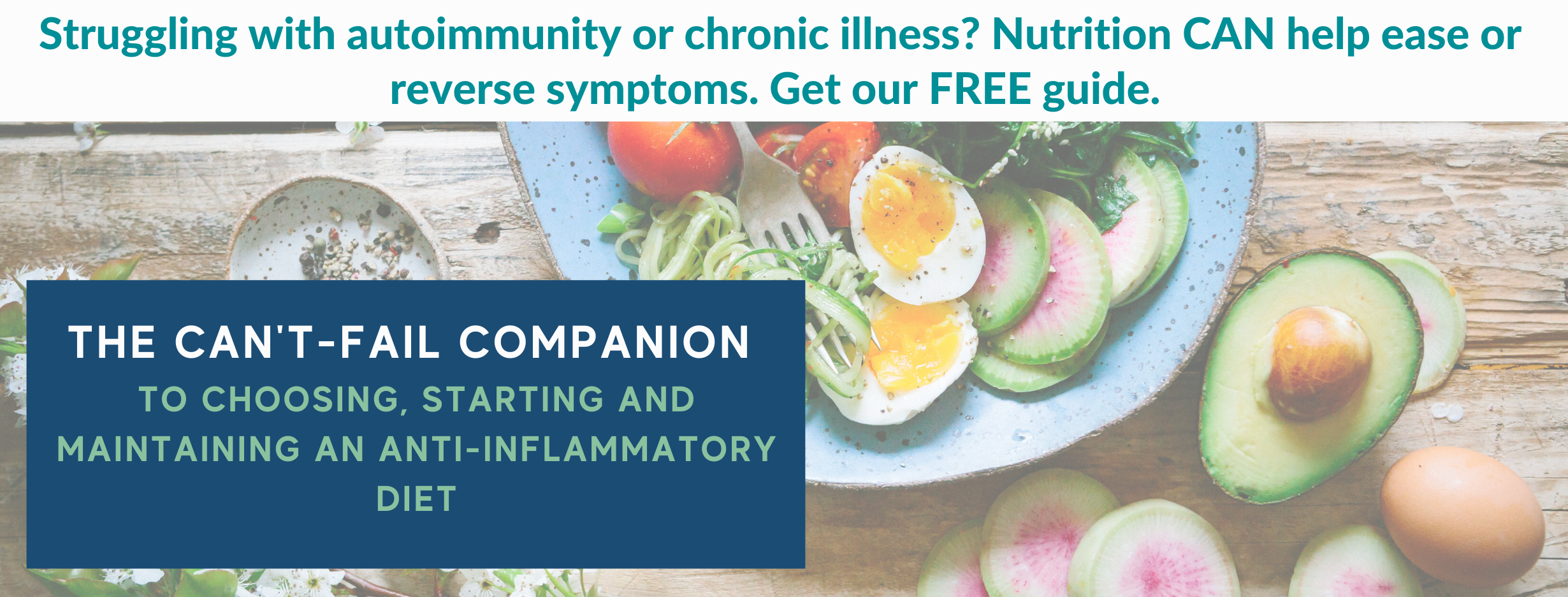11 Tips for Sticking to an Anti-Inflammatory Diet
A few years ago, I embarked on a gut-healing, anti-inflammatory diet – desperate to alleviate chronic gastrointestinal symptoms related to SIBO (small intestinal bacterial overgrowth), plus chronic inflammation.
For 30 days, I would eliminate grains, dairy, refined sugar and about 30 foods to which I had recently tested sensitive.
In those early days, it was a meal-by-meal challenge. It took more time, brainpower – and will power – than I ever expected. For every meal, I struggled to figure out what to eat and adhere to the diet.
Between searching for recipes, shopping and cooking, feeding myself became a part-time job!
I marked off each day on the calendar, and could tell anyone who asked which day I was on.
Fortunately, my body acted as a fast feedback loop. Almost immediately, my uncomfortable gastrointestinal issues subsided – completely.
Did that make it any easier to adhere to the diet early on? Kind of.
It was still hard and I still counted every day. But knowing it worked gave me the resolve to continue.
Healthy Eating Habits Built in 90 Days
They say 30 days of doing something can make it a habit. But for me, it took closer to 90 days to build a healthy eating habit.
But the good news is, that restrictive diet did become a habit.
Years later, I’m still on a similar diet.
Why and how have I remained on limited diet for so long? Because the payoff is too great. Cheating, for me, just isn’t worth it. I can’t risk getting SIBO again. And eating this way keeps my inflammation down, brain healthy, blood sugar in check and my body well-nourished.
How Do You Stick to an Anti-Inflammatory Diet?
In recent years, paleo-style diets such as Whole30 have become popular, for good reason. People see benefits, even if they’re not contending with chronic illness of some sort. They may have more energy, lose weight, improve digestion or feel more clear-headed (no more brain fog), among other benefits.
For others, a therapeutic diet can reduce systemic inflammation and alleviate chronic GI troubles.
If you’re considering embarking on such a diet, how do you stick to it – whether it’s 30 days, three years or three decades?
Here are my top tips for sticking to an anti-inflammatory diet:
1. Clear out cheat foods
If it’s not there, you can’t eat it! Rid your pantry and fridge of anything not compliant with your diet, as best you can. If you live with others not on the diet, that may not be so easy.
At a minimum, clear out your top go-to bad foods. What do you usually grab at 3 pm? What’s your post-meal sweet treat? Replace them with healthier options.
Explain to those living with you why you’re trying the diet and get their support. If they need to hide some of their own favorite non-compliant foods, then at least they’re out of your sight!
2. Plan meals for the week
Don’t get caught without a plan for your next meal. Organize meals ahead of time, preferably by the week. Shop and stock up all at once so you have everything on hand. Then write down the schedule to reduce the chance of cheating.
3. Cook ahead
If possible, cook meals ahead and freeze them. A friend of mine spends Sundays cooking all the meals for the week. Another hires a college student to cook with her for a few hours once a month to make a stock load of meals for the freezer.
4. Allow more meal-prep time
My husband and I used to whip up a “bag” for dinner – one of those all-in-one frozen meals that usually included rice or pasta with veggies and meat. In 10 minutes, we had dinner.
Not so anymore. Those meals have grains and too many additives.
Now, we cook everything from scratch, which usually takes about an hour for dinner. But it’s an investment in our health. We’re consuming considerably less processed food than before (none in my case).
Know that preparing freshly made, nutritious meals typically takes more time and schedule for that.
5. Don’t cook separate meals
When I began an anti-inflammatory diet, my husband and son did not. To accommodate us all, we often make a meat, vegetable and grain – and I just don’t eat the grain. At times, my husband also sticks with just the meat and veggies, and has come to love many of the grain-free favorites that we now make.
Check out my Favorite Resources page for some of the cookbooks and blogs I rely on.
Occasionally, I cook special treats just for me, like cassava-flour pancakes topped with blueberries or chocolate cake that’s actually compliant with my diet.
6. Stock compliant snacks
Be ready when hunger strikes. Arm yourself with compliant items. That varies depending on your diet. For me, that might be roasted pumpkin seeds or carrots and hummus.
7. Find substitutes that sound good
When you start a new diet, your body may rebel with cravings. Fortunately, those cravings may calm down as your body gets used to the new diet.
Do you crave salty stuff? Sweet stuff? Have alternatives at the ready. Swap chips for salted, roasted veggies. Or try a homemade dessert sweetened with honey or maple syrup if those are allowed on your diet.
8. Get an app for that
For meal-planning, shopping or eating out, know the “legal” foods on your diet. For my diet of choice, the Specific Carbohydrate Diet, I referred to a website with an alphabetical list of legal foods.
However, there are numerous apps to help you with specific diets, from the Specific Carbohydrate Diet to low FODMAP.
9. Know when you’re willing to cheat
What’s acceptable to cheat with? What’s not?
For the first 30 days of the diet, I remained strict and steadfast. After a month, I gave myself a small cheat break before starting the diet again. And I have had a few small cheat breaks in between in special circumstances (ahem, macarons in Paris).
If I choose to cheat, I usually do so with foods that, in limited quantity, won’t set back my gut health, such as a small amount of white rice. But I have remained resolute about not eating gluten or more than a tiny amount of refined sugar. It’s not worth it!
10. Find favorite restaurants
We all need a break from cooking at times. Find a few go-to restaurants where you can order food on your diet. At many places, you can find a healthy salad, or meat and veggies. Look at the menu online ahead of time.
Just be sure you really know what’s in the food. Your server may have to ask the cooks, which can be a pain, but you don’t want to accidentally consume some of the big no-nos on your diet.
11. BYOF (Bring Your Own Food)
What if friends invite you over? Don’t let your unusual diet keep you at home.
Let friends or family know you’re on a specific diet and that you’ll plan to bring food that you can eat – instead of asking hosts to cook a special meal for you.
It’s one thing if you’re just gluten-free or dairy-free, but for diets such as Whole 30 or paleo, it’s very tough for others to accommodate you.
Going on an anti-inflammatory diet can be seriously tough. There will be moments and whole days when you want to just get a drive-through hamburger and fries.
But know that some cheats can seriously set you back and that an anti-inflammatory diet can make a major impact on your health. You’ll feel better quickly and stay off medications that can cause serious side effects. It gets easier. I promise.
If you enjoyed this story, you might also like Woman Reverses Multiple Sclerosis Symptoms after Swapping Drugs for Diet, Lifestyle.
The information on this site is for educational and inspirational purposes only and is not intended to replace the advice of qualified professionals. Keep in mind that what works for one person may not work for another. Always consult your healthcare practitioners before beginning new approaches or treatments. Some links on Rebuilding My Health may be affiliate links. This means that we may receive a commission - with no additional cost to you - if you make any purchases using those affiliate links. Rebuilding My Health is a participant in the Amazon Services LLC Associates Program. Learn more.



